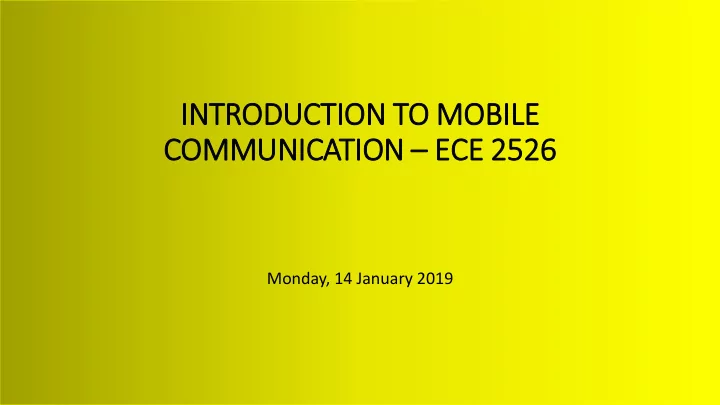

IN INTRODUCTION TO MOBILE COMMUNICATION – ECE 2526 Monday, 14 January 2019
ETI 2526-CURRICULUM(1) ETI 2526 Mobile Communication (45 Lecture Hours) Prerequisites ECE 2214 Electromagnetic fields Purpose To enable the student understand: (a) radio propagation characteristics, (b) cellular communication system, and (c) digital modulation techniques of a mobile radio. Learning Outcomes At the end of this course, the student should be able to: 1. Explain the characteristics of radio propagation. 2. Describe the cellular communication system 3. Explain the digital modulation techniques of a mobile radio as well as mobile access techniques. 4. Simulate a model of cellular communication system.
ETI 2526-CURRICULUM (2) Course Description • Radio propagation characteristics: Models for path loss, shadowing and multipath fading (delay spread, coherence bandwidth, coherence time, Doppler spread, Jakes' channel model. • Digital modulation for mobile radio: Analysis under fading channels; diversity techniques and Rake demodulator. • Introduction to spread spectrum communication. • Multiple access techniques used in mobile wireless communications: FDMA/TDMA, CDMA. • The cellular concept: Frequency reuse; the basic theory of hexagonal cell layout; spectrum efficiency. • FDM/TDM Cellular systems: channel allocation schemes. Handover analysis. Cellular CDMA; soft capacity. Erlang capacity comparison of FDM/TDM systems and cellular CDMA.
ETI 2526-CURRICULUM (3) • Discussion of GSM standards: signaling and call control; mobility management; location tracing. • Wireless data networking: packet error modeling on fading channels, performance analysis of link and transport layer protocols over wireless channels; mobile data networking (mobile IP); • Wireless data in GSM, IS-95, and GPRS.
RECOMMENDED BOOKS Course Textbooks 1. Dharma P. Agrawal and Qing-An Zeng (2010), Introduction to Wireless and Mobile Systems , CL-Engineering, 3rd edition. ISBN-13: 978-1439062050. 2. Ian Poole (2006), Cellular Communications Explained: From Basics to 3G , Newnes, 1st edition. ISBN-13: 978-0750664356. 3. Garg V.K. & Wilkes J. E. (2007), Principles and Applications of GSM , Pearson Education. Reference Textbooks 1. G.L.Stuber (2006), Principles of Mobile Communication , Kluwer Schiller J. (2007), Mobile Communications, 2nd Ed, Pearson Education 2. Rich Ling and Jonathan Donner (2009), Mobile Phones and Mobile Communication , Polity, 1st edition. ISBN-13: 978-0745644141. 3. Reza Zekavat and R. Michael Buehrer (2011), Handbook of Position Location: Theory, Practice and Advances , Wiley-IEEE Press, 1st edition. ISBN-13: 978-0470943427
COURSE WEBSITE ECE2526.elimu.net
Recommend
More recommend